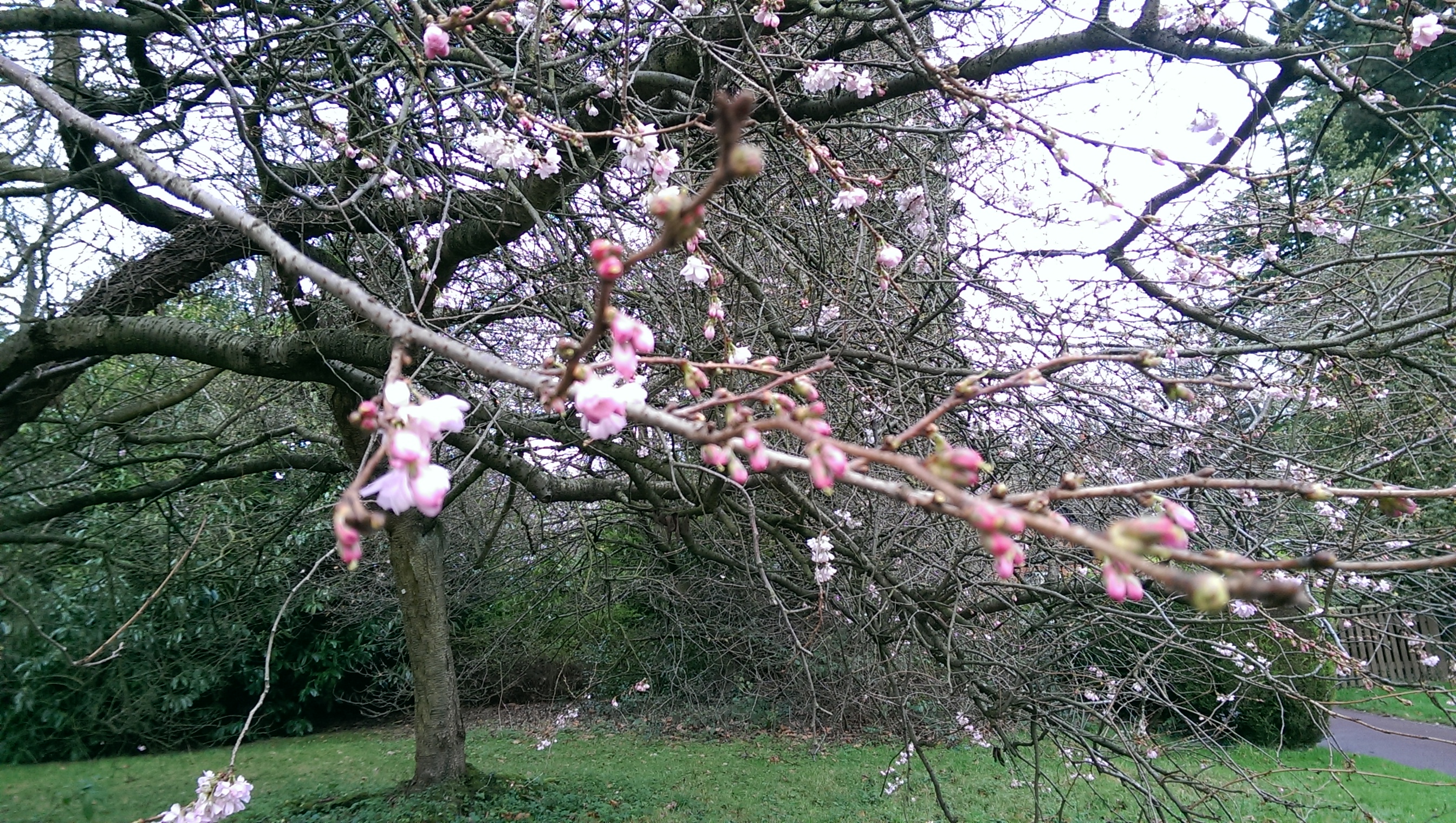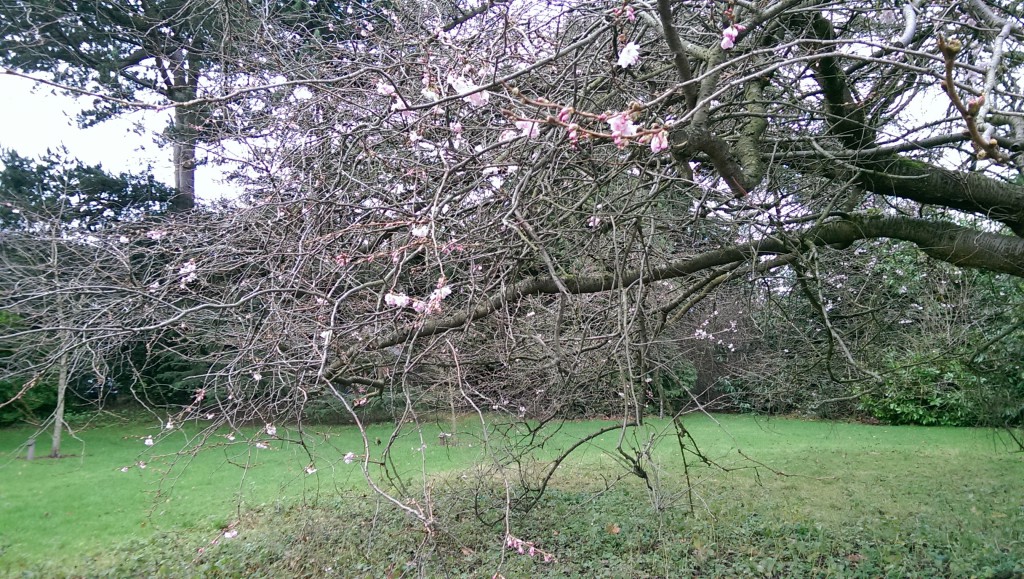
December 18, 2015, by Lucy
Cherry Blossom and Daffodils: Mild Decembers in the Archive
This week the Weather Extremes team has been catching up in Nottingham. As well as reviewing recent activity, setting goals for the year ahead, and Christmas plans, the conversation frequently turned to the weather itself. The mild weather that much of the country is currently experiencing was one talking point, as blossom and other traditional ‘signs of spring’ can be seen on the University campus.
Whilst mild weather might not normally be included in the category of ‘extreme’ weather events, one thing that can make an event extreme is the time of year at which it occurs, and by implication its unexpected nature. So, as hopes of a White Christmas fade we thought we’d round off our blogging for 2015 by exploring mild Decembers of years past.
Why is it so mild?
The BBC has produced a short report considering ‘BBC Why is it so mild?’ The feature explains that this year’s strong El Nino event might be playing a part in the present influx of warm air over the UK. However, no temperature records have been broken yet. The warmest day ever recorded in December was 18.3 degrees C in Scotland on 2 December 1948. The Met Office has also produced a blog on the mild start to December 2015.
Mild Decembers of winters past
Much of our project data has now been inputted into our database and so over lunch on Wednesday we began exploring historical accounts of mild Decembers – a useful test of our search tool! Many of our narrative accounts pre-date the instrumental record, enabling a much longer picture of mild winters to be assembled. There is no easy way of comparing them to the present conditions, but references to the flowering of trees and what are traditionally thought of as ‘signs of spring’ can be a good proxy for instrumental data.
Signs of spring and ‘green winters’
References to the weather being ‘spring like’, and to signs in nature are fairly common in the narratives that we’ve collected over the past two years. On 28th November 1738 Richard Wilkes of Staffordshire described how:
The Weather was very moderated & the Air so mild; that the Grass Sprung & the meadows look as green as if it had been April. We have not yet had a Frost to bear a man upon the Ice (5350, p. 162, Staffordshire Record Office).
In Revesby, Lincolnshire, on 18 January 1759, William Banks wrote about the weather of previous weeks:
Jan 18 – The weather is so mild & warm as never was known in the memory of man at this time of the year, & has been so for a month or more last past & indeed there has hardly been any winter like weather yet, been but 2 frosts & they continued not above 2 or 3 days each, no snow to lye & very little rain, good land has all ye winter looked green & growing, very little hay eat, the thrushes & other birds begin to whistle, highish winds & westerly without rain, all footpaths quite dry and padded, white daisies & primroses (RA/2/C/1/1, Lincolnshire Archives).
The idea of a ‘green winter’ comes from the diary of William Thomas of Michaelston super Ely in South Wales who recorded the mild winter of 1769-70:
- Saturday December 9th: The finest weathr. In my memory at such times of ye year
- December 31st: mild weathr. considering ye time of ye year
- January 29th 1770: Daisy and other flowers in full bloom
- January 30th: This winter may be called ye green winter
John Clifton’s daybooks cover some very hard winters in Barnwell, Northamptonshire, as well as a number of mild Decembers, including 1778 when ‘Christmas day as mild as May day’ (ZA8742, Northamptonshire Record Office).
The winter of 1796 as recorded in the parish register for Clipston, Northamptonshire, was said to have been very mild indeed, meaning that what appeared on the dinner table was rather ‘unseasonal’:
1796 – Jany 18th – we have hitherto had no winter, the weather is mild and the fields exhibit a verdure unparalleled in the memory of man, yesterday the sun was all day unclouded, and birds of all sorts chortled their vernal lays – the streets are now dry and walking is pleasant; fine salads appeared on my table wch the natural ground produced in a south aspect… Batts were seen flying abt this evening, daises are very plentiful & luxuriant (CLIPSTON 70P/3, Northamptonshire Record Office).
Jonathan Wilshire’s collection of newspaper cuttings in Leicestershire, Leicester and Rutland Record Office includes a snippet on December 1806 in Leicester when:
As a further proof of the unnatural mildness of the season there are several apple trees in Welford in this county which have within the last few days been in bloom and one belonging to Mr Porter, saddler, has several which are set and are as long as gooseberries (DE4828/Box 3, in repository Leicestershire, Leicester and Rutland Record Office).
Garden flowers are another common reference point for mild conditions, as in this example from a newspaper cutting on Worcestershire Record Office from 1821:
Dec 19 1821 – Mildness of the season. There are now in Mr Turner’s garden Park Hall in this county, chrysanthemums, carnations, pinks, a great variety of ? and many other flowers in full blossom in the open air, a singular proof of the extraordinary mildness of the season (899/749/xii, Worcestershire Record Office).
A detailed summary of December 1857 in Moulton went as follows:
This has been one of the most extraordinary months experienced in memory from commencement to ending the weather has been very open clear and mild with only six slight hoar frosts which proved quite harmless to the most tender of vegetation. Many subjects of summer and autumnal decoration are revelling in health and weekly records are made in the Gardeners Chronicle of the protracted flowering or growth of various summer plants and shrubs which are generally locked in dormancy at this season of the year. The premature blossoming of many spring flowers are also engaging the attention of observers. Publicity is also given by the same source of extraordinary freaks of nature in the vegetable kingdom. Falling stars are seen on the 17th and a beautiful rainbow on the 21st inst (Box 125 43 MO, National Meteorological Library and Archive).
Mild winters and work
In general warm weather in December makes life easier, no worries about fuel and keeping warm, less animals to feed, and no travel disruption. But some new jobs can also emerge, like mowing the lawn, as JH Green of Mowsley explained in December 1897, ‘the weather continued so mild that I mowed my lawn on December 21, & took off three barrow loads of grass’ (DE3389/145, Leicestershire, Leicester and Rutland Record Office).
Other activities simply couldn’t happen, such as the collection of ice to be stored through the year. In 1900-01 Charles Isham Strong noted ‘We got very little ice (practically none) owing to the mildness of the winter’ (ST454, Northamptonshire Record Office).
Mild Decembers and illness?
One group that could seemingly find themselves with an increased workload during mild winters were doctors. In the winter of 1786-87, physician Matthew Flinders of Donington, Lincolnshire, detailed what he thought was a link between the mild winter weather and the accelerated rates of illness he has observed during his work:
I may remark that this has been the mildest winter we have had for several years past, we have has no long severe frosts but a considerable share of mild weather – on the contrary I scarce remember a more sickly winter. I have had much more Business than I had in the 3 preceding severe ones, this almost amounts to a proof that frost and cold are useful in preserving the human frame in health & that after the relaxing heats of Summer and Autumn, a frosty winter is a useful & restorative bracer, we have had several intermittents in the family among the children, but I thank God none of any disagreeable continuance (FLINDERS 2, Lincolnshire Archives).
A couple of our records from the nineteenth century also link mild winter conditions to outbreaks of illness, as is the case in these church records from Frettenham, Norfolk for December 1847 and from Droitwich, Worcestershire for 1861:
- A very mild winter, influenza & bad colds prevalent (PD 279/3, repository Norfolk Record Office).
- Dec – on xmas day we had a very good attendance… and sermons on the 4 Saturday as the weather was so mild. During the past month there has been a great deal of fever… the weather has been unusually mild and dry, only 2 nights as yet of frost (850DROITWICHSPA/10, Worcestershire Record Office).
Walter Davies (Gwalter Mechain) of Meifod, Powys, often looked for links between the weather and behaviour. During the winter of 1802-03 he recorded a very open winter that he forecast would lead to a increased mortality among the Welsh people once severe weather arrived:
So uncommon – that sheep were left on the open wastes, without being taken into inclosures till the 10th of January – when the frost set in. This winter verified the old adage Hâf tan galan – a Gauaf hyd Wyl Ifan. A mild winter is vulgarly supposed to forerun a mortality among the people – Gauaf glâs wnâ fonwent frâs – This may be founded on the effect that a sudden change from mildness to extreme severity of weather, has upon weak constitutions, and which they can hardly recover from. When hard weather sets in early in winter, it is not in general so severe or so lasting as when it be deferred beyond the solstice (MS 1762 B ii, National Library of Wales).
Record ‘milds’
Into the twentieth century and the ready reference of temperatures with the instrumental record, there are more comparisons with the temperatures of previous years. William Richmond of Nottingham commented in his diary that, ‘1934 ended with the most wet for December since 1914 and warmest for over 120 years’ (DD/2535/5, Nottinghamshire Archives).
Radio, and later television, reports informed people when records were broken. In December 1953, Mary Elizabeth King in Birmingham knew immediately that, ‘The first six days in December is registered as the warmest for over a century’. This was enforced by her own observation that, ‘There is an abundance of bird melody around for this time of year’ (MS1547/32, Birmingham City Archives).
The following report from E.H. Morse in Brundall, Norfolk, from December 1949 also picks up this theme and seems like a very appropriate extract to end the year with:
Dec – warmest night on roof of air ministry Dec 26th for 67 years, temperature 56, Christmas Day warmest for 50 years – so said the BBC. Fred Rose & Geo. Forester reported that crowds of people were sitting on seats at 5pm on Nottingham market Place reading the newspapers by the light from the xmas tree 40 ft high, Dec 27th (MC 145/1, Norfolk Record Office).
I wonder how many people will be doing that next Friday!
Merry Christmas from the Weather Extremes team. Thanks for reading.
No comments yet, fill out a comment to be the first


Leave a Reply